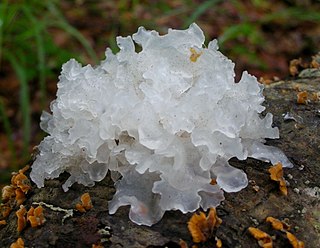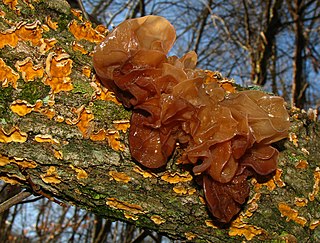
Tremella fuciformis is a species of fungus; it produces white, frond-like, gelatinous basidiocarps. It is widespread, especially in the tropics, where it can be found on the dead branches of broadleaf trees. This fungus is commercially cultivated and is one of the most popular fungi in the cuisine and medicine of China. T. fuciformis is commonly known as snow fungus, snow ear, silver ear fungus, white jelly mushroom, and white cloud ears.

Phaeotremella frondosa is a species of fungus in the family Phaeotremellaceae producing brownish, frondose, gelatinous basidiocarps. It is widespread in north temperate regions, and is parasitic on other species of fungi that grow on dead attached and recently fallen branches of broadleaf trees.

Phaeotremella foliacea is a species of fungus in the family Phaeotremellaceae. It produces brownish, frondose, gelatinous basidiocarps and is parasitic on the mycelium of Stereum sanguinolentum, a fungus that grows on dead attached and recently fallen branches of conifers. It is widespread in north temperate regions. In the UK it has the recommended English name leafy brain and has also been called jelly leaf and brown witch's butter. Prior to 2017, the name Tremella foliacea was also applied to similar-looking species on broadleaf trees, now distinguished as Phaeotremella frondosa and Phaeotremella fimbriata.

Tremella iduensis is a species of fungus in the family Tremellaceae. It produces yellow, cornute-frondose, gelatinous basidiocarps and is parasitic on other fungi, probably species of Hypoxylon on dead attached and recently fallen branches of broad-leaved trees. It has been recorded from Japan and China. Tremella flava, described from Taiwan, may be a synonym.
Tremella wrightii is a species of fungus in the family Tremellaceae. It produces light brown to orange-brown, lobed, gelatinous basidiocarps and is parasitic on other fungi on dead branches of broad-leaved trees. It was originally described from Cuba.

Tremella vesiculosa is a species of fungus in the family Tremellaceae. It produces light brown, lobed, gelatinous basidiocarps and is parasitic on other fungi on dead branches of broad-leaved trees. It was originally described from New Zealand.

Tremella samoensis is a species of fungus in the family Tremellaceae. It produces red to orange-yellow, lobed to firmly foliaceous, gelatinous basidiocarps and is parasitic on other fungi on dead branches of broad-leaved trees. It was originally described from Samoa and the Philippines, but is widely distributed in the region.
Tremella olens is a species of fungus in the family Tremellaceae. It produces soft, whitish, lobed to frondose, gelatinous basidiocarps and is parasitic on other fungi on dead branches of broad-leaved trees. It was originally described from Tasmania.
Tremella brasiliensis is a species of fungus in the family Tremellaceae. It produces yellow, lobed to firmly foliaceous, gelatinous basidiocarps and is parasitic on other fungi on dead branches of broad-leaved trees. It was originally described from Brazil.
Tremella rubromaculata is a species of fungus in the family Tremellaceae. It produces reddish orange, lobed, gelatinous basidiocarps and is parasitic on other fungi on dead branches of broad-leaved trees. It was originally described from Guatemala.
Tremella roseolutescens is a species of fungus in the family Tremellaceae. It produces rose-pink to salmon, pustular, gelatinous basidiocarps and is parasitic on other fungi on dead attached branches of broad-leaved trees. It was originally described from Costa Rica.
Tremella erythrina is a species of fungus in the family Tremellaceae. It produces orange to red, lobate to foliaceous, gelatinous basidiocarps and is parasitic on other fungi on wood of broad-leaved trees. It was originally described from China.
Tremella armeniaca is a species of fungus in the family Tremellaceae. It produces orange to apricot, lobed, gelatinous basidiocarps and is parasitic on other fungi on dead branches of broad-leaved trees. It was originally described from Costa Rica.
Tremella coffeicolor is a species of fungus in the family Tremellaceae. It produces brown, lobed to foliaceous, gelatinous basidiocarps and is parasitic on other fungi on dead branches of broad-leaved trees. It was originally described from Bermuda, where it was collected as part of the Challenger expedition.
Tremella exigua is a species of fungus in the family Tremellaceae. It produces small, dark, pustular, gelatinous basidiocarps and is parasitic on pyrenomycetous fungi on dead branches of trees and shrubs. It was originally described from France.
Tremella mesenterella is a species of fungus in the family Tremellaceae. It produces yellowish to reddish brown, foliose, gelatinous basidiocarps and is parasitic on corticioid fungi on dead branches of broadleaf trees and shrubs. It was originally described from Canada.
Pseudotremella moriformis is a species of fungus in the family Bulleraceae. It produces dark purple, pustular, gelatinous basidiocarps and is parasitic on pyrenomycetous fungi on dead herbaceous stems and wood. It was originally described from England.
Tremella tremelloides is a species of fungus in the order Tremellales. It produces yellowish, brain-like to densely lobed, gelatinous basidiocarps and is parasitic on Stereum basidiocarps on dead branches of broadleaved trees. It was originally described from the USA.
Tremella steidleri is a species of fungus in the order Tremellales and has the recommended English name brown brain. It produces brown, brain-like, gelatinous basidiocarps and is parasitic on Stereum basidiocarps on dead branches of broadleaved trees. It was originally described from the Czech Republic.
Tremella compacta is a species of fungus in the order Tremellales. It produces large, ochraceous yellow, compactly lobed, cartilaginous-gelatinous basidiocarps on dead branches of broadleaved trees. It was originally described from Brazil and is distributed in northern South America, Central America, and the Caribbean.





